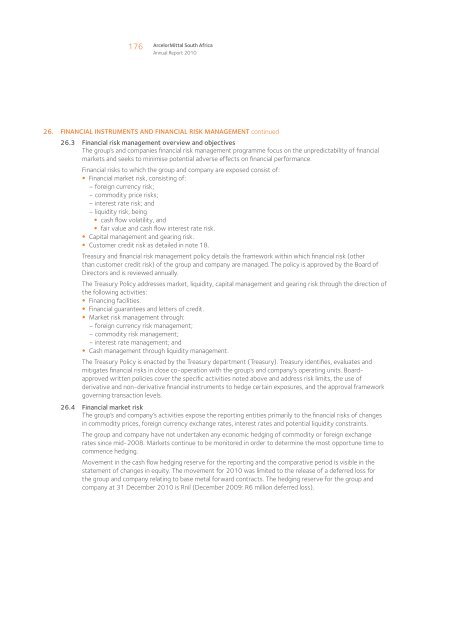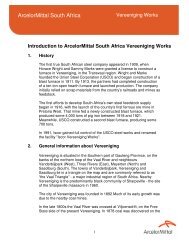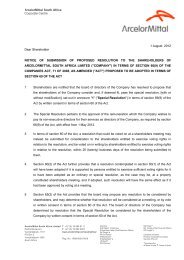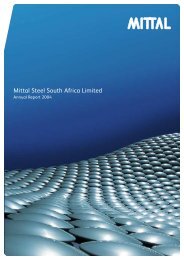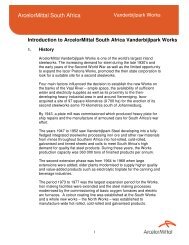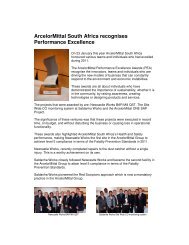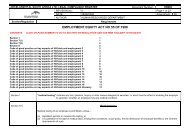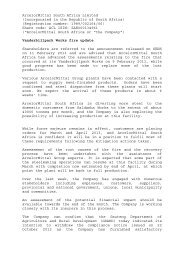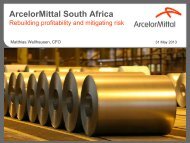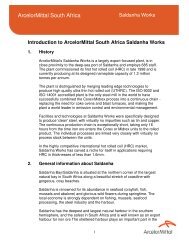bold spirit - ArcelorMittal South Africa
bold spirit - ArcelorMittal South Africa
bold spirit - ArcelorMittal South Africa
Create successful ePaper yourself
Turn your PDF publications into a flip-book with our unique Google optimized e-Paper software.
176<br />
<strong>ArcelorMittal</strong> <strong>South</strong> <strong>Africa</strong><br />
Annual Report 2010<br />
26. FINANCIAL INSTRUMENTS AND FINANCIAL RISK MANAGEMENT continued<br />
26.3 Financial risk management overview and objectives<br />
The group’s and companies financial risk management programme focus on the unpredictability of financial<br />
markets and seeks to minimise potential adverse effects on financial performance.<br />
Financial risks to which the group and company are exposed consist of:<br />
• Financial market risk, consisting of:<br />
– foreign currency risk;<br />
– commodity price risks;<br />
– interest rate risk; and<br />
– liquidity risk, being<br />
• cash flow volatility, and<br />
• fair value and cash flow interest rate risk.<br />
• Capital management and gearing risk.<br />
• Customer credit risk as detailed in note 18.<br />
Treasury and financial risk management policy details the framework within which financial risk (other<br />
than customer credit risk) of the group and company are managed. The policy is approved by the Board of<br />
Directors and is reviewed annually.<br />
The Treasury Policy addresses market, liquidity, capital management and gearing risk through the direction of<br />
the following activities:<br />
• Financing facilities.<br />
• Financial guarantees and letters of credit.<br />
• Market risk management through:<br />
– foreign currency risk management;<br />
– commodity risk management;<br />
– interest rate management; and<br />
• Cash management through liquidity management.<br />
The Treasury Policy is enacted by the Treasury department (Treasury). Treasury identifies, evaluates and<br />
mitigates financial risks in close co-operation with the group’s and company’s operating units. Boardapproved<br />
written policies cover the specific activities noted above and address risk limits, the use of<br />
derivative and non-derivative financial instruments to hedge certain exposures, and the approval framework<br />
governing transaction levels.<br />
26.4 Financial market risk<br />
The group’s and company’s activities expose the reporting entities primarily to the financial risks of changes<br />
in commodity prices, foreign currency exchange rates, interest rates and potential liquidity constraints.<br />
The group and company have not undertaken any economic hedging of commodity or foreign exchange<br />
rates since mid-2008. Markets continue to be monitored in order to determine the most opportune time to<br />
commence hedging.<br />
Movement in the cash flow hedging reserve for the reporting and the comparative period is visible in the<br />
statement of changes in equity. The movement for 2010 was limited to the release of a deferred loss for<br />
the group and company relating to base metal forward contracts. The hedging reserve for the group and<br />
company at 31 December 2010 is Rnil (December 2009: R6 million deferred loss).


